Intro
Learn about Ondansetron 4mg tablets, used for nausea prevention, including dosage, side effects, and interactions, with information on antiemetic medication and vomiting relief.
Ondansetron 4mg tablets are a commonly prescribed medication for the prevention and treatment of nausea and vomiting. These tablets contain the active ingredient ondansetron, which belongs to a class of medications known as serotonin 5-HT3 receptor antagonists. The importance of understanding the uses, benefits, and potential side effects of ondansetron 4mg tablets cannot be overstated, as they play a crucial role in managing symptoms that can significantly impact a patient's quality of life.
Nausea and vomiting are symptoms that can arise from various conditions, including chemotherapy, radiation therapy, and surgery. In some cases, these symptoms can be so severe that they lead to dehydration, electrolyte imbalances, and even malnutrition. Ondansetron 4mg tablets have been shown to be effective in preventing and treating these symptoms, allowing patients to undergo necessary medical treatments without the debilitating effects of nausea and vomiting. Furthermore, the ability to manage these symptoms can greatly improve a patient's overall well-being and ability to recover from illness or surgery.
The mechanism by which ondansetron 4mg tablets work involves blocking the action of serotonin, a natural substance that can trigger nausea and vomiting. By blocking serotonin receptors in the brain and the digestive tract, ondansetron helps to reduce the likelihood of nausea and vomiting. This makes ondansetron an invaluable medication for patients undergoing treatments that are known to cause these symptoms. The effectiveness of ondansetron has been extensively studied, and it is widely recognized as a first-line treatment for preventing nausea and vomiting in various clinical settings.
Ondansetron 4mg Tablet Uses
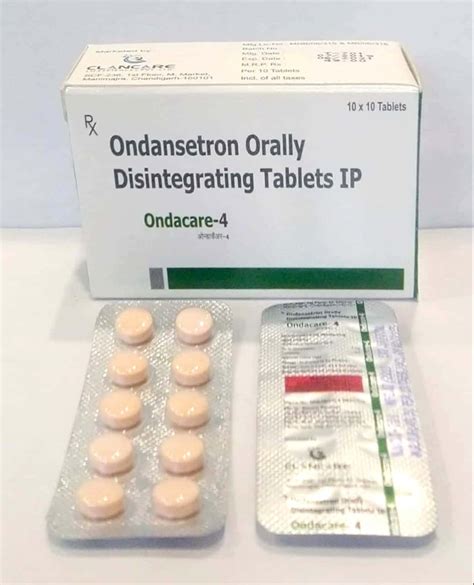
Ondansetron 4mg tablets are primarily used for the prevention of nausea and vomiting caused by chemotherapy, radiation therapy, and surgery. They can be administered orally, usually 30 minutes to 1 hour before the start of chemotherapy or radiation therapy, and as needed for post-operative nausea and vomiting. The dosage and frequency of administration may vary depending on the patient's condition, age, and the type of treatment they are undergoing. It is essential for patients to follow the dosage instructions provided by their healthcare provider to ensure the safe and effective use of ondansetron 4mg tablets.
Benefits of Ondansetron 4mg Tablets
The benefits of ondansetron 4mg tablets are numerous and significant. They offer patients a reliable means of managing nausea and vomiting, which can be a major obstacle to undergoing necessary medical treatments. By preventing these symptoms, ondansetron 4mg tablets can help patients avoid the complications associated with severe nausea and vomiting, such as dehydration and malnutrition. Additionally, the ability to manage these symptoms can greatly improve a patient's quality of life, allowing them to maintain their strength and resilience during challenging treatments.How Ondansetron 4mg Tablets Work

The working mechanism of ondansetron 4mg tablets involves the selective inhibition of serotonin 5-HT3 receptors. Serotonin is a neurotransmitter that plays a crucial role in initiating the vomiting reflex. By blocking the action of serotonin at the 5-HT3 receptors, ondansetron prevents the trigger for nausea and vomiting, thereby reducing the incidence of these symptoms. This targeted action makes ondansetron a highly effective medication for preventing and treating nausea and vomiting in various clinical settings.
Steps for Taking Ondansetron 4mg Tablets
To ensure the safe and effective use of ondansetron 4mg tablets, patients should follow these steps: - Take the medication exactly as directed by the healthcare provider. - Administer the tablets orally with water. - For chemotherapy-induced nausea and vomiting, take the first dose 30 minutes before the start of chemotherapy. - For radiation therapy, take the first dose 1 hour before radiation. - For post-operative nausea and vomiting, follow the dosage instructions provided by the healthcare provider. - Do not crush or chew the tablets; swallow them whole.Ondansetron 4mg Tablet Side Effects
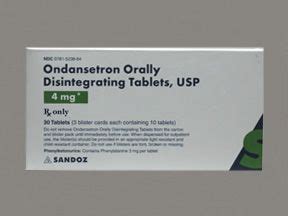
While ondansetron 4mg tablets are generally well-tolerated, they can cause side effects in some patients. Common side effects include headache, dizziness, constipation, and diarrhea. Less common but more serious side effects can include allergic reactions, changes in heart rhythm, and severe constipation. Patients should report any side effects to their healthcare provider, who can provide guidance on managing these effects or adjusting the treatment plan as necessary.
Practical Examples of Ondansetron Use
In clinical practice, ondansetron 4mg tablets are used in a variety of settings. For example, a patient undergoing chemotherapy for cancer may be prescribed ondansetron to prevent nausea and vomiting. Similarly, a patient scheduled for surgery may receive ondansetron as part of their pre-operative regimen to reduce the risk of post-operative nausea and vomiting. These practical applications demonstrate the versatility and effectiveness of ondansetron in managing symptoms that can significantly impact a patient's quality of life.Ondansetron 4mg Tablet Interactions
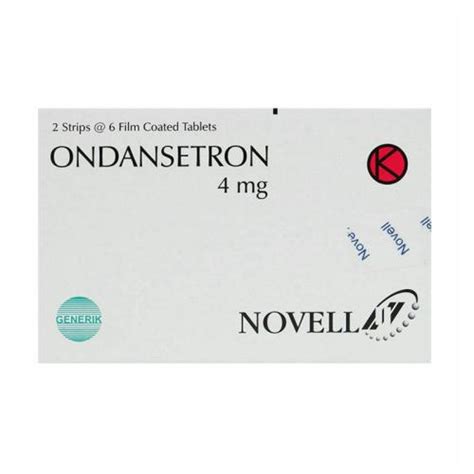
Ondansetron 4mg tablets can interact with other medications, which may affect their efficacy or increase the risk of side effects. Patients should inform their healthcare provider about all medications they are taking, including prescription drugs, over-the-counter medications, and herbal supplements. Certain medications, such as apomorphine, can interact with ondansetron, and their use may need to be adjusted or avoided.
Statistical Data on Ondansetron Efficacy
Numerous studies have demonstrated the efficacy of ondansetron in preventing nausea and vomiting. For example, in clinical trials involving patients undergoing chemotherapy, ondansetron has been shown to reduce the incidence of acute nausea and vomiting by up to 80%. Similarly, in patients undergoing surgery, ondansetron has been effective in reducing the risk of post-operative nausea and vomiting. These statistical data underscore the importance of ondansetron in clinical practice and highlight its role as a first-line treatment for managing nausea and vomiting.Ondansetron 4mg Tablet Dosage
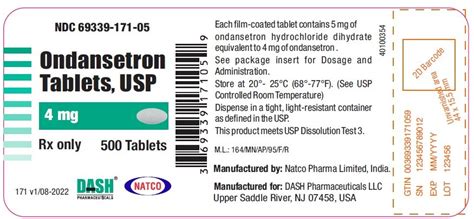
The dosage of ondansetron 4mg tablets can vary depending on the patient's condition and the type of treatment they are undergoing. For chemotherapy-induced nausea and vomiting, the usual dosage is 8mg administered 30 minutes before chemotherapy, followed by 8mg every 8 hours for 2 days. For radiation therapy, the dosage is typically 8mg administered 1 to 2 hours before radiation, and then every 8 hours for up to 2 days. For post-operative nausea and vomiting, the dosage may be a single 16mg dose or 8mg every 8 hours for up to 2 days. Patients should follow the specific dosage instructions provided by their healthcare provider.
Key Information for Patients
Patients taking ondansetron 4mg tablets should be aware of the following key information: - Take the medication as directed by the healthcare provider. - Report any side effects to the healthcare provider. - Inform the healthcare provider about all medications being taken. - Do not stop taking the medication without consulting the healthcare provider. - Keep the medication out of reach of children.Ondansetron 4mg Tablet Storage and Disposal
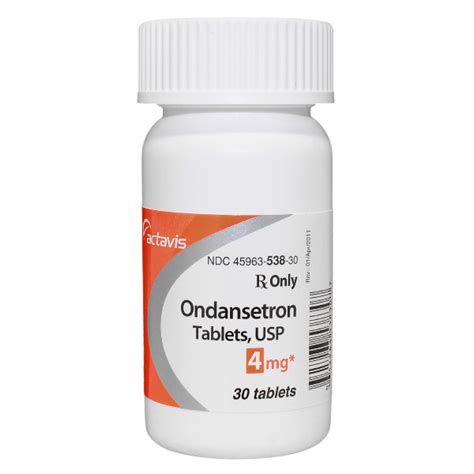
Ondansetron 4mg tablets should be stored in a cool, dry place, away from direct sunlight and moisture. Patients should keep the medication in its original packaging and out of reach of children. Unused or expired medication should be disposed of properly, following the guidelines provided by the healthcare provider or local pharmacy. It is essential to handle and dispose of medication safely to prevent accidental ingestion and environmental contamination.
Conclusion and Future Directions
In conclusion, ondansetron 4mg tablets are a highly effective medication for the prevention and treatment of nausea and vomiting. Their mechanism of action, benefits, and potential side effects make them a valuable tool in clinical practice. As research continues to uncover new applications and formulations of ondansetron, its role in managing symptoms and improving patient outcomes is likely to expand. Patients and healthcare providers should stay informed about the latest developments and guidelines to ensure the safe and effective use of ondansetron 4mg tablets.We invite readers to share their experiences or ask questions about ondansetron 4mg tablets in the comments section below. Your feedback and insights can help others better understand the benefits and challenges of using this medication. Additionally, consider sharing this article with anyone who may benefit from the information provided, as awareness and education are key to improving healthcare outcomes.
What is the primary use of ondansetron 4mg tablets?
+Ondansetron 4mg tablets are primarily used for the prevention of nausea and vomiting caused by chemotherapy, radiation therapy, and surgery.
How do ondansetron 4mg tablets work?
+Ondansetron 4mg tablets work by blocking the action of serotonin at the 5-HT3 receptors, which helps to prevent nausea and vomiting.
What are the common side effects of ondansetron 4mg tablets?
+Common side effects include headache, dizziness, constipation, and diarrhea. Less common but more serious side effects can include allergic reactions and changes in heart rhythm.
Can ondansetron 4mg tablets interact with other medications?
+Yes, ondansetron 4mg tablets can interact with other medications. Patients should inform their healthcare provider about all medications they are taking.
How should ondansetron 4mg tablets be stored and disposed of?
+Ondansetron 4mg tablets should be stored in a cool, dry place and disposed of properly following the guidelines provided by the healthcare provider or local pharmacy.
